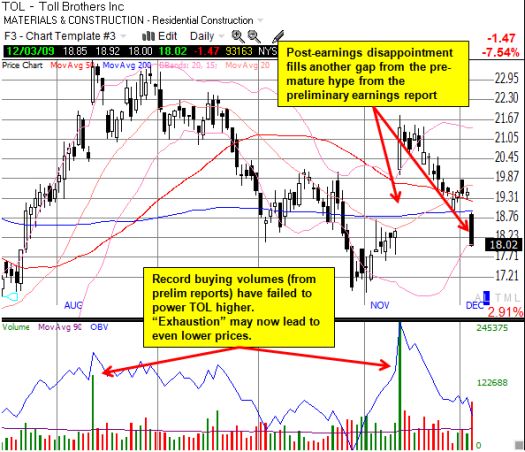For Toll Brothers (TOL), history has a nasty habit of repeating itself. Over the last two quarters, TOL released preliminary earnings reports that propelled the stock to one-day double-digit gains on record trading volumes. For the second time in a row, the actual earnings report generated the exact opposite response. After the last earnings report, TOL slid 27% over two months before bottoming in late October. Yesterday, TOL dropped almost 8% in one day and is now down 16% from the close after November’s preliminary report.

*Chart created using TeleChart: 
It seems investors did not like TOL’s guidance that suggested margins will be lower next year (all quotes from the transcript provided by Seeking Alpha):
“We estimate the average delivered price per home between $540,000 and $560,000. We believe that primarily due to incentives, fewer deliveries and lower average sales prices, our cost of sales before interest and write-down as a percentage of revenues will be higher in fiscal 2010 than in 2009.”
My core problem with TOL’s stock has been the continued massive selling by insiders. To-date, these $61M in sales have been quite timely (click here to review a chart showing the timing of the sales). After reviewing TOL’s latest earnings conference call, I get the impression that TOL insiders are not selling because they expect some specific terrible event. Instead, they are likely expressing their nervousness over an uncertain future.
For example, TOL reported that the housing market has remained choppy since Labor Day and the outlook remains cloudy:
“The choppiness in demand that began after Labor Day following a stronger period for late March through late August, has continued. Since the holiday season is not typically the time to be purchasing or selling homes, we suspect the housing market may be following seasonal buying patterns. We believe it may take some time for Americans to regain confidence in our economy, their job status, and the benefits of home ownership. Currently we anticipate a gradual recovery in housing, similar to the one that occurred over several years coming out of the last recession in the early 90s…”
“…With respect to choppy waters, you just have to bite the finger, be patient, and wait until you see what comes out in the latter part of January, all of February, and the early part of March. We can’t tell, things are not clear enough now for us to state that it is anything other than seasonality…We don’t have an answer. I wish we did…”
TOL is not even sure whether it is finished laying off employees:
“For the time being, we have stopped lopping headcount and have decided to stick with the organization, the team that we’ve got, until we get through first quarter and a half fiscal, or calendar first quarter…If we continue to see choppy waters in January and February and part of March, then we’ll go back into the business of lessening headcount… “
Over four years after the housing bubble peaked, TOL still cannot express much confidence in the future. While TOL did float a teaser about future potential buybacks or a debt buyback during this conference call, the company also indicated it will be holding onto a substantial cash cushion: “…having gotten whacked coming through the last four years, at least until our memory fades and we get greedy again, for the next couple of years we don’t expect to use all of our cash.”
In other interesting commentary, TOL talked about the consolidation in its industry, the lack of impact from the extension of the homebuyer’s tax credit, and specific regions exhibiting pricing power:
Strong competitive position (albeit in a shrinking market):
“Many of the small and mid-sized private builders who historically have been our primary competitors in a luxury niche are facing serious capital constraints among other problems, and are either hobbled or no longer in business. The other major public homebuilding companies remain focused primarily on the lower end of the housing market rather on the luxury niche.”
No impact from extension of homebuyer’s credit:
“I don’t think we’ve seen a tax bump…for a move-up, you’re a second-time home buyer, you’re talking about 6500. Our average single family home is probably 7, 7-and-a-quarter. The [MOPIs] are about 450 and on average — so I don’t think we are going to see in our line of work much of an inflection due to the tax credit.”
Locations in the country currently experiencing pricing power:
“…we saw it in Massachusetts, we saw it in Connecticut, we saw it in the New York suburbs. We saw it in the City Living product in both Jersey City, Hoboken, and in Manhattan and Brooklyn. We saw it in the State of New Jersey. We saw a little bit of it in Maryland…”
Be careful out there!
Full disclosure: short TOL
